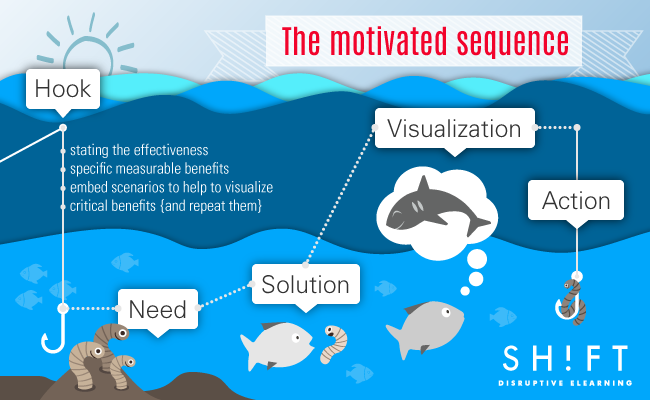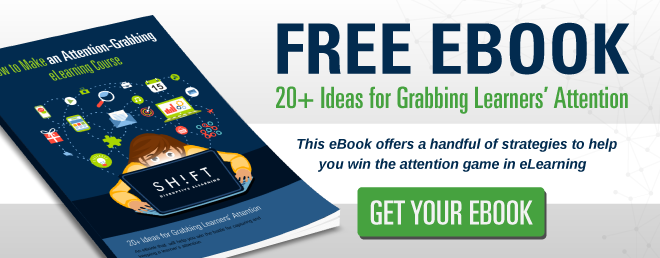Persuasion is an art. Try too hard, and you might be branded as being aggressive. Be gentle, and your message will probably be brushed aside. At the end, the ultimate goal of persuasion is to get a person to change. Persuading someone to come round to your point of view is especially challenging in a virtual learning environment that lacks the intimacy of a face-to-face interaction. What is more, your learner has a choice to go or not go through your course. Thankfully, researchers have figured out how the learner's mind works and how to "persuade" it to fall in line with your content.
Monroe's Motivated Sequence lists a proven process—Hook, Need, Solution, Visualization, and Action—to convert a reluctant learner into an enthusiastic participant who readily absorbs the learning and willingly agrees to change his behavior. In eLearning, "telling isn't teaching," and you cannot persuade if you just state the facts. Facts alone won’t significantly change the way people think, do, and feel. You have to carefully choose every element on the screen to do all the coaxing, cajoling, imploring, and pleading to engage and persuade your learners to do something new.
Follow this no-fail process for creating eLearning that persuades and changes behaviors.

Step #1: Hook: Tell Them What's In It for Them
Adult learners are goal-oriented. They are practical individuals who want to know how taking a course will help them at the workplace or resolve issues in other spheres of their lives. They are probably busy professionals who have career goals to meet, families to take care of, and dreams of spending their sunset years comfortably. So if you want to woo them with your course, you have to dish out the learning in a way they can apply it in their real lives.
- Warm them up to your course by stating the effectiveness of the learning material right at the outset. The most effective ploy is not always to plunk down a list of learning objectives laced with Bloom's action verbs. Reserve the jargon for other times; instead, speak in their language.
- Mention specific measurable benefits. The benefits of learning soft skills are hard to measure, but here is a tip: research your target audience, find out about their performance goals, and tie in the benefits with these. For instance, if your course wants to teach time management skills, point out benefits like reduction in the duration of meetings.
- Embed scenarios to help learners visualize the benefits in the mind's eye. Take this opportunity to highlight a pain point in your learner's professional life and use the scenario to explain how learning new behavioral skills will help him solve his problems.
- Choose a few critical benefits of taking the course and refer to these often. Remind the learner how the lack of a skill is hampering his climb up the corporate ladder, and repeat. Keeping up the motivation level of the learners throughout the duration of the course is a challenge for eLearning professionals. Being often reminded of the benefits of taking the course will keep the learner interested. But do not go overboard; the adult learner also does not like being dictated to.
Step #2: State the Need and Provide a Solution
Advertisers do this often, and ad copywriters are noted for their persuasion skills. Their copies do not sound impersonal. Instead, the writers inject personality in the messages to help the brands engage with their audience and build a rapport with them. The adult learner is more responsive to cues provided by someone who they perceive to be friendly and understanding rather than a faceless, impersonal entity.
Get into the shoes of the learner and identify his specific problems that the course can resolve. Now take the PAS (Problem-Agitate-Solve) approach. After you have gently pointed out the pain point, explain to the learner how it is sabotaging his life and preventing him from realizing his dreams. As you may have realized, this is a subtle ploy to agitate the learners (read: make them concerned), so they are more open to the solutions you next propose.
Throughout the course, write in a knowledgeable but friendly manner. You need to establish yourself as an authority on the subject, but do not put off the learner with scholarly aloofness. Write like you would talk to a friend, and the learner will readily accept your ideas. Do not chide him for his woes; instead, show empathy. Assure him that his situation is not uncommon, and the solutions are right at hand. The adult learner wants to be talked to, not talked at.
Step #3: Ultimately, Take the Lessons Out of the Learning Environment and Into the Real Life
The adult learner learns best and appreciates the lesson most when he can place it in context of his life's situations. His motivation level shoots up when he finds relevance and meaning in the learning. After all, the art of persuasion is not just about seizing the learner by his throat and making him gulp down your teach.
Present real-life scenarios to make the learner appreciate the relevance of altering his behavior or cultivating a new habit. Choose characters who match the demographic characteristics of most of your learners. Use examples to get them to see benefits of the new idea.
Once you've got them to see the benefits of the new idea, put them into action. Design activities for the learner to test his learning and to make him realize the consequences of his decisions and actions. The adult learner learns by doing. He has left his learning-by-heart days of school, and now wants to know how he can apply his learning. An eLearning course lets the learner boldly test his learning in a consequence-free environment.
The key to create persuasive soft skills training is to use words, scenes, associations, and emotions that resonate with your audience. The adult learner is practical, so you have to come across as an expert in your field. But he is also an emotional human being who is persuaded more easily by a friend than a business.



